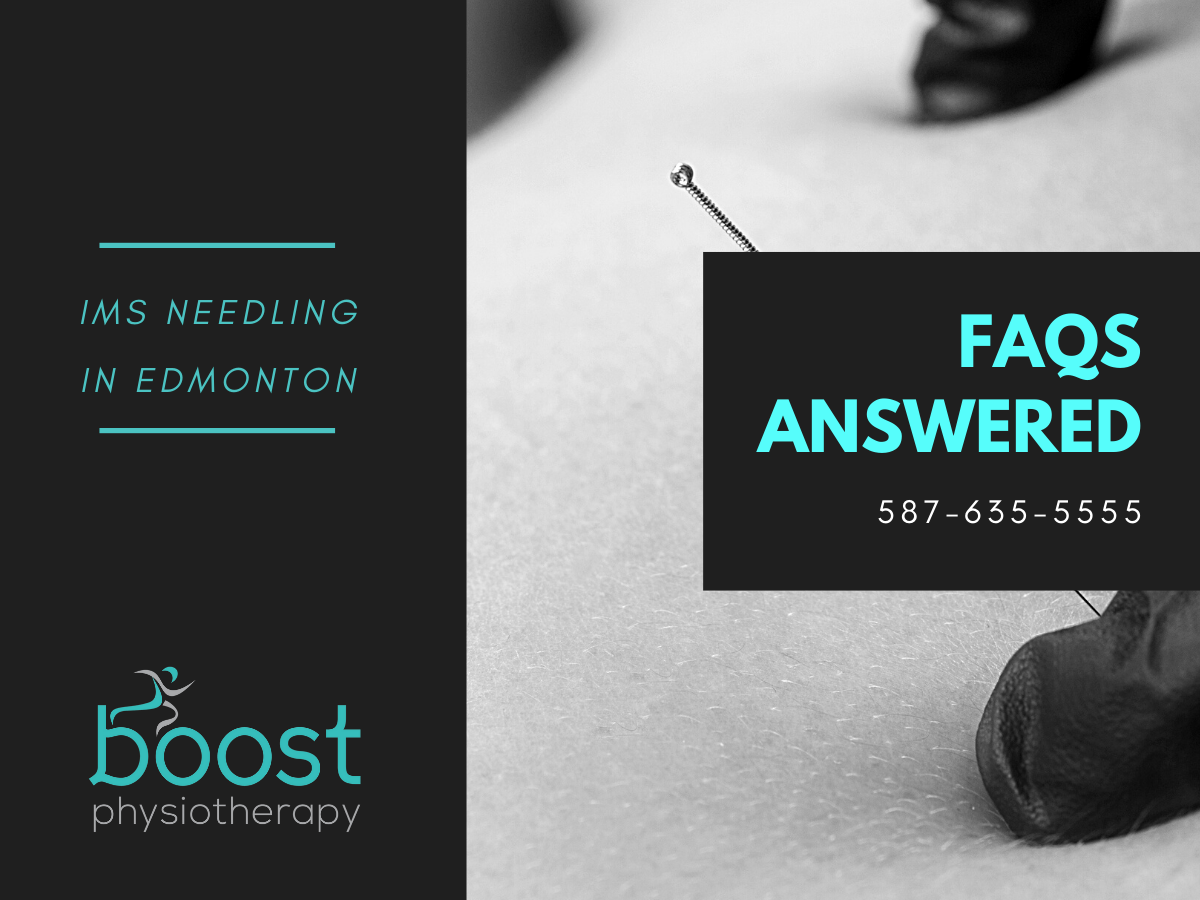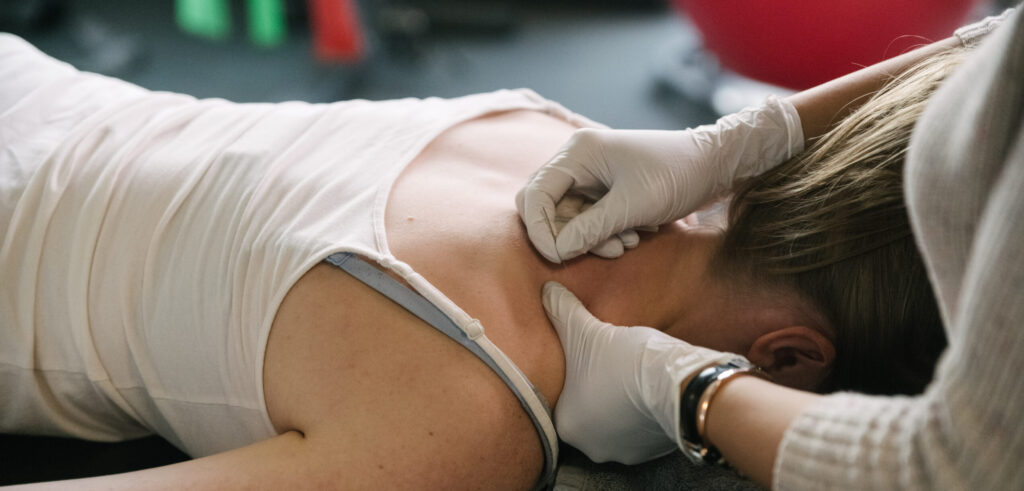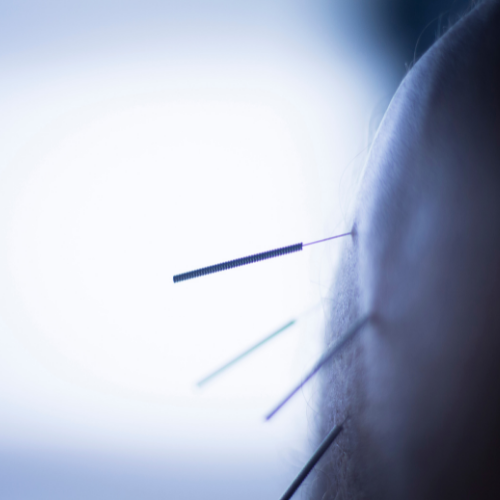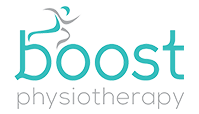
IMS Needling (Intramuscular Stimulation) in Edmonton – 7 FAQs Uncovered
IMS needling is a common practice of a trained IMS physiotherapist, where acupuncture needles get inserted into tight muscle groups (trigger points).

#IMSNeedling
The purpose of inserting these needles into the tight muscle groups is to reduce pain and improve mobility. Often, a cause and source of pain or poor mobility are from muscles compensating for an injury at another part of the body. By inserting the IMS needles into the trigger points (IMS Needling), the patient feels a deep ache or twitching sensation as the needle moves through the tight muscles. The process is repeated over and over again at different trigger points. Although you might be sore the next day, IMS needling “resets” and relaxes the muscles, improving mobility and function. At no point during the process should you be in any pain or severe discomfort.
What does IMS needling do?
Needling, in general, has been around since the early 1900s with the primary focus of trigger points and determining what needs work. IMS operates by targeting profound muscles, and the needles themselves are pulled in and out as the physical therapist feels the tightness of the muscle.
Through this process, IMS instigates constrictions and helps the muscles overstretch, which triggers the ligaments joined to it. The ligaments sense the muscle is overstretched where the spine interacts and causes that point of the muscle to unwind. It produces a quick yet effective relief from discomfort.
IMS itself is a very dynamic process that requires a significant amount of information concerning the professional regarding life systems and muscle banding. With IMS, physiotherapists can guarantee that suitable regions are treated to reestablish ideal development and relieve discomfort for their patients.
Common types of conditions where IMS treatment can help?
- Migraines
- Alleviates Slipped Plates
- Back And Lower Back Pain
- Neck Pain (chronic or acute)
- Tennis Elbow
- Stiffness
- Chronic Pain
- Tennis Elbow
- Golfer’s Elbow
- General Muscle Stiffness

Is IMS needling the same as dry needling?
Often, people confuse IMS needling with dry needling, primarily because of their name differences. IMS needling is actually a form of dry needling. There is also a combination known as IMS dry needling to some physical therapists.
IMS needling acquires alleviation from a needle that’s inserted into a tight band of muscle (trigger point). A trigger point is a hyper-touchy spot in a rigid band of skeletal muscle excruciating on pressure, stretch, overburden, or withdrawal of the tissue.
The needle is embedded into the skin and muscle and is guided a few times to get a reaction. Most people feel exhausted and stimulated for a few weeks after treatment because of the needle sensation.
In comparison, dry needles are inserted into the muscle directly around a trigger point several times to elicit a twitch response. Dry needling sessions are lengthier but not as intense compared to IMS needling.
How long does it take for IMS to work?
Intramuscular stimulation (IMS) successfully releases fixed muscles and lessens pain as soon as someone completes their first treatment. However, most people can expect three to four sessions to see results from IMS, with most injuries settling after eight to ten meetings.
Many people are surprised at how quickly IMS alleviates pain and solves the issue that could be hindering them for such a long time. It’s a significant highlight why people should try to help themselves instead of ignoring the issue for a long time. It’s much more beneficial to address the issue instead of ignoring it.
Why does IMS hurt?
Patients can expect an aching pain and twitch from the needle points. This sensation isn’t painful per se, but causes cramping and aching. However, the sensation lets therapists know the muscle had a trigger point that was causing movement issues. If the muscle doesn’t have a trigger point in it, then the needling will be pain-free.
After the session concludes, patients feel sore for a day or two. The minor achiness is expected, and as long as patients stay active, it should subside quickly.
Although the pain may seem like an annoyance at first, the benefits certainly outweigh the minor inconvenience pain-wise. This pain is a result of the body’s reaction to something external plucking through it.
How often can you get IMS?
Treatment with IMS is usually done once per week but can be every two weeks depending on the person. This relies upon how severe a person’s agony is, the manner by which someone is advancing with treatment, and how long that person has been having pain. Aside from once a week, it’s not recommended for someone to get IMS any more frequently.
Like any other needling, people need to be careful with how often they’re getting it. Some physiotherapists may try to get someone simply because it’s a way to make money. Still, great physiotherapists understand how sensitive the human body is and why someone should follow the instructions with how frequently they can get IMS.
What are the benefits of IMS Needling?
The primary reason why any person would get IMS needling done on them is because of the vast array of benefits tied to the matter. Not only is it a quick and relatively straightforward procedure, but studies have shown IMS relaxes muscles, improves blood flow, alleviates pain, and much more. Here is a quick list of some of the most common benefits of IMS needling:
- Relaxes Muscles
- Improves Blood Flow
- Treats Chronic Pain
- Decreases Pain
- Releases Neurotransmitters
- Improves Movements
- Helps Lower Back Issues
- Alleviates Neck Pain
- Aids Tennis Elbow
- Rids Migraines
- Helps Spinal Dysfunction
- Aids Joint Dysfunction
Where Can I Get IMS Needling in Edmonton?
If you’re searching for IMS Needling (intramuscular stimulation) in Edmonton our expert physiotherapists at Boost PT can help.
Boost ensures a hands-on approach and one on one time with your therapist every time you come in.
We take the time to know you, your condition, and the abundance of factors that affect your pain. Make an appointment today to see how IMS needing helps you recover from short or long-term injury.
BY: boostptepadmin
Acupuncture, Ims
COMMENTS: No Comments
